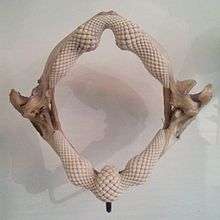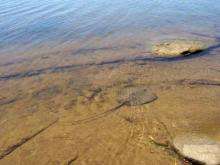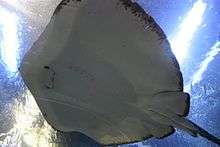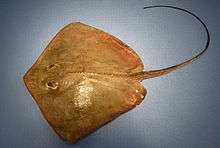Stingray
| Stingrays Temporal range: Early Cretaceous–Recent[1] | |
|---|---|
 | |
| Common stingray (Dasyatis pastinaca) | |
| Scientific classification | |
| Kingdom: | Animalia |
| Phylum: | Chordata |
| Class: | Chondrichthyes |
| Subclass: | Elasmobranchii |
| Order: | Myliobatiformes |
| Suborder: | Myliobatoidei |
| Families | |
Stingrays are a group of rays, which are cartilaginous fish related to sharks. They are classified in the suborder Myliobatoidei of the order Myliobatiformes and consist of eight families: Hexatrygonidae (sixgill stingray), Plesiobatidae (deepwater stingray), Urolophidae (stingarees), Urotrygonidae (round rays), Dasyatidae (whiptail stingrays), Potamotrygonidae (river stingrays), Gymnuridae (butterfly rays), and Myliobatidae (eagle rays).[1][2]
Most stingrays have one or more barbed stingers (modified from dermal denticles) on the tail, which are used exclusively in self-defense. The stinger may reach a length around 35 cm (14 in), and its underside has two grooves with venom glands.[3] The stinger is covered with a thin layer of skin, the integumentary sheath, in which the venom is concentrated.[4] A few members of the suborder, such as the manta and porcupine rays, do not have stingers.[5]
Stingrays are common in coastal tropical and subtropical marine waters throughout the world. Some species, such as Dasyatis thetidis, are found in warmer temperate oceans, and others, such as Plesiobatis daviesi, are found in the deep ocean. The river stingrays, and a number of whiptail stingrays (such as the Niger stingray), are restricted to fresh water. Most myliobatoids are demersal (inhabiting the next-to-lowest zone in the water column), but some, such as the pelagic stingray and the eagle rays, are pelagic.[6]
While most stingrays are relatively widespread and not currently threatened, for several species (for example Taeniura meyeni, D. colarensis, D. garouaensis, and D. laosensis), conservation status is more problematic, leading to their being listed as vulnerable or endangered by IUCN. The status of several other species is poorly known, leading to their being listed as data deficient.[7]
Behavior
The flattened bodies of stingrays allow them to effectively conceal themselves in their environments. Stingrays do this by agitating the sand and hiding beneath it. Because their eyes are on top of their bodies and their mouths on the undersides, stingrays cannot see their prey; instead, they use smell and electroreceptors (ampullae of Lorenzini) similar to those of sharks.[8] Stingrays feed primarily on molluscs, crustaceans, and occasionally on small fish. Some stingrays' mouths contain two powerful, shell-crushing plates, while other species only have sucking mouthparts. Stingrays settle on the bottom while feeding, often leaving only their eyes and tails visible. Coral reefs are favorite feeding grounds and are usually shared with sharks during high tide.[9]
Reproduction
When a male is courting a female, he follows her closely, biting at her pectoral disc. He then places one of his two claspers into her valve.[10]
Stingrays are ovoviviparous, bearing live young in "litters" of five to 13. The female holds the embryos in the womb without a placenta. Instead, the embryos absorb nutrients from a yolk sac, and after the sac is depleted, the mother provides uterine "milk".[11]
At the Sea Life London Aquarium, two female stingrays have delivered seven baby stingrays, although the mothers have not been near a male for two years. "Rays have been known to store sperm and not give birth until they decide the timing is right".[12]
Diet
A stingray's diet includes small fish, snails, clams, and shrimp, and some other small sea creatures.[13]
Stingray injuries
Stingrays are not aggressive and only attack humans when provoked, such as if a ray is accidentally stepped on.[14] To avoid stepping on a stingray in shallow water, the water should be waded through with a shuffle.[15] Alternatively, before wading, stones can be thrown into the water to scare stingrays away.[16] Contact with the stinger causes local trauma (from the cut itself), pain, swelling, muscle cramps from the venom, and later may result in infection from bacteria or fungi.[17] The injury is very painful, but seldom life-threatening unless the stinger pierces a vital area.[14] The barb usually breaks off in the wound, and surgery may be required to remove the fragments.[18]
Fatal stings are very rare, but can happen,[14] most famously in the death of Steve Irwin in 2006, in which the stinger penetrated his thoracic wall, causing massive trauma.[19]
As food
Rays are edible, and may be caught as food using fishing lines or spears.[20] Stingray recipes abound throughout the world, with dried forms of the wings being most common. For example, in Malaysia and Singapore, stingray is commonly grilled over charcoal, then served with spicy sambal sauce, or soy sauce. Generally, the most prized parts of the stingray are the wings (flaps is the proper terminology), the "cheek" (the area surrounding the eyes), and the liver. The rest of the ray is considered too rubbery to have any culinary uses.[21]

While not independently valuable as a food source, the stingray's capacity to damage shell fishing grounds can lead to bounties being placed on their removal.[22]
Ecotourism
Stingrays are usually very docile and curious, their usual reaction being to flee any disturbance, but they sometimes brush their fins past any new object they encounter. Nevertheless, certain larger species may be more aggressive and should be approached with caution, as the stingray's defensive reflex (use of its poisoned stinger) may result in serious injury or death.[23]
Stingrays are not normally visible to swimmers, but divers and snorkelers may find them in shallow, sandy waters, more so when the water is warm. In the Cayman Islands, several dive sites called Stingray City, Grand Cayman, allow divers and snorkelers to swim with large southern stingrays (D. americana) and feed them by hand. There are many companies that offer these stingray city trips, making it the number one tourist attraction in Grand Cayman. Every year hundreds of thousands of tourists visit this pristine sandbar, and virtually no one gets injured, meaning that these rays are extremely friendly to humans.[24] A "Stingray City" in the sea surrounding the Caribbean island of Antigua consists of a large, shallow reserve where the rays live, and snorkeling is possible, since the rays are used to the presence of humans.[25]
In Belize, off the island of Ambergris Caye, a popular marine sanctuary, Hol Chan, has divers and snorkelers often gathering to watch stingrays and nurse sharks drawn to the area by tour operators who feed the animals.
Many Tahitian island resorts regularly offer guests the chance to "feed the stingrays and sharks". This consists of taking a boat to the outer lagoon reefs, then standing in waist-high water while habituated stingrays swarm around, pressing right up against tourists seeking food from their hands or that being tossed into the water. The boat owners also "call in" sharks, which, when they arrive from the ocean, swoop through the shallow water above the reef and snatch food offered to them.[26]
Other uses
The skin of the ray is used as an under layer for the cord or leather wrap (known as ito in Japanese) on Japanese swords due to its hard, rough, skin texture that keeps the braided wrap from sliding on the handle during use. They are also used to make exotic shoes, boots, belts, wallets, jackets, and cellphone cases.[27]
Several ethnological sections in museums,[28] such as the British Museum, display arrowheads and spearheads made of stingray stingers, used in Micronesia and elsewhere.[29] Henry de Monfreid stated in his books that before World War II, in the Horn of Africa, whips were made from the tail of big stingrays, and these devices inflicted cruel cuts, so in Aden, the British forbade their use on women and slaves. In former Spanish colonies, a stingray is called raya látigo ("whip ray").
Monfreid also wrote in several places about men of his crew suffering stingray wounds while standing and wading into Red Sea shallows to load or unload smuggled wares: he wrote that to "save the man's life", searing the wound with a red-hot iron was necessary.[30]
Stingrays have more benefits than being used for human consumption. Their behaviours are very calm and friendly; and as such, many waterparks e.g. Discovery Cove (Owned by SeaWorld), Create a habitat within pools, where they and people are able to interact within a safe environment. SeaWorld home 'More than 200 stingrays- some with wingspans up to 5-feet'.[31] Within the main SeaWorld park there are small pools where people are able to interact and feed the stingrays. In addition, they also have small nurseries which are home to the stingrays' pups, these are also open for interactions, but because they are young, they tend to hide beneath the sand.
 Barbecued stingray is commonly served in Singapore and Malaysia
Barbecued stingray is commonly served in Singapore and Malaysia A Stingray City in Grand Cayman allows swimmers, snorkelers, and divers to swim with and feed the stingrays.
A Stingray City in Grand Cayman allows swimmers, snorkelers, and divers to swim with and feed the stingrays.- Stingray wallets
 Early Eocene fossil stingray Heliobatis radians
Early Eocene fossil stingray Heliobatis radians Stingray in shallows
Stingray in shallows
Fossils
Although stingray teeth are rare on sea bottoms compared to the similar shark teeth, scuba divers searching for the latter do encounter the teeth of stingrays. Permineralized stingray teeth have been found in sedimentary deposits around the world, including fossiliferous outcrops in Morocco.[32]
See also
References
- 1 2 Nelson, J.S. (2006). Fishes of the World (fourth ed.). John Wiley. pp. 76–82. ISBN 0-471-25031-7.
- ↑ Helfman, G.S.; B.B. Collette; D.E. Facey (1997). The Diversity of Fishes. Blackwell Science. p. 180. ISBN 978-0-86542-256-8.
- ↑ Ternay, A. "Dangerous and Venomous Aquarium Fish" (PDF). fishchannel.com.
- ↑ Meyer, P. (1997). "Stingray injuries". Wilderness Environ Med. 8 (1): 24–8. doi:10.1580/1080-6032(1997)008[0024:SI]2.3.CO;2. PMID 11990133.
- ↑ Froese, Rainer and Pauly, Daniel, eds. (2009). "Urogymnus asperrimus" in FishBase. September 2009 version.
- ↑ Bester, C.; H. F. Mollett; J. Bourdon. "Pelagic Stingray". Florida Museum of Natural History, Ichthyology department.
- ↑ "IUCN Red List". International Union for Conservation of Nature. Archived from the original on June 27, 2014.
- ↑ Stingray behavior?. Scubaboard.com. Retrieved on 2012-07-17.
- ↑ Stingray City – Altering Stingray Behavior & Physiology?. Divephotoguide.com (2009-04-14). Retrieved on 2012-07-17.
- ↑ FAQs on Freshwater Stingray Behavior. Wetwebmedia.com. Retrieved on 2012-07-17.
- ↑ Florida Museum of Natural History Ichthyology Department: Atlantic Stingray. Flmnh.ufl.edu. Retrieved on 2012-07-17.
- ↑ "Zoo staff thought stingrays in female-only tank were bloated... that was until they gave birth to SEVEN pups". Daily Mail. 2011-08-10.
- ↑ "What Do Animals Eat?". What Do Animals Eat?. 2014. Retrieved July 11, 2014.
- 1 2 3 Slaughter RJ; Beasley DM; Lambie BS; Schep LJ (2009). "New Zealand's venomous creatures". N Z Med J. 122 (1290): 83–97. PMID 19319171. Archived from the original on April 17, 2011.
- ↑ Parsons GR (2006) Sharks, skates, and rays of the Gulf of Mexico: a field guide, pp. 46–47. University Press of Mississippi. ISBN 978-1-57806-827-2
- ↑ Vaitilingam A and Thomas P The Rough Guide to Jamaica Edition 2, p. 417. ISBN 978-1-84353-111-1
- ↑ "Stingray Injury Case Reports". Clinical Toxicology Resources. University of Adelaide. Retrieved 22 October 2012.
- ↑ Flint D; Sugrue W (1999). "Stingray injuries: a lesson in debridement". N Z Med J. 112 (1086): 137–8. PMID 10340692.
- ↑ Discovery Channel Mourns the Death of Steve Irwin. animal.discovery.com
- ↑ Can you eat stingray? – Spearboard Spearfishing Community. Spearboard.com. Retrieved on 2012-07-17.
- ↑ The Delicious and Deadly Stingray. Nyonya. New York, NY. (Partially from the Archives.). Deep End Dining (2006-09-05). Retrieved on 2012-07-17.
- ↑ eating stingray – Spearboard Spearfishing Community. Spearboard.com. Retrieved on 2012-07-17.
- ↑ Sullivan, B. N. (May 2009). Stingrays: Dangerous or Not?. The Right Blue. Retrieved on 2012-07-17.
- ↑ https://georgeswatersports.ky/stingray-city-grand-cayman/
- ↑ Adam, David (2009-05-29). "Stingrays suffering from wildlife tourism, study finds". The Guardian. London.
- ↑ Petting a stingray – Tahiti Scuba & Snorkelling. Viator.com. Retrieved on 2012-07-17.
- ↑ Swordmaking Anatomy. Chioky.deviantart.com. Retrieved on 2012-07-17.
- ↑ FLMNH Ichthyology Department: Daisy Stingray. Flmnh.ufl.edu. Retrieved on 2012-07-17.
- ↑ Dasyatis rudis (Smalltooth Stingray). Iucnredlist.org. Retrieved on 2012-07-17.
- ↑ Stingray Injury Causes, Symptoms, Diagnosis, Treatment, and Prevention Information on. Emedicinehealth.com. Retrieved on 2012-07-17.
- ↑ Parks, S., & Entertainment. (2016). Stingray Lagoon®. Retrieved November 1, 2016, from https://seaworldparks.com/en/seaworld-orlando/attractions/exhibits/stingray-lagoon
- ↑ Heliobatis radians Stingray Fossil from Green River. Fossilmall.com. Retrieved on 2012-07-17.
Bibliography
- Froese, Rainer, and Daniel Pauly, eds. (2005). "Dasyatidae" in FishBase. August 2005 version.
External links
- University of Pennsylvania Health System – Information on stingray poison.
- Life In The Fast Lane: Toxicology Conundrum #012
- "Beware the Ugly Sting Ray." Popular Science, July 1954, pp. 117–118/pp. 224–228.
| Wikimedia Commons has media related to Stingray. |

